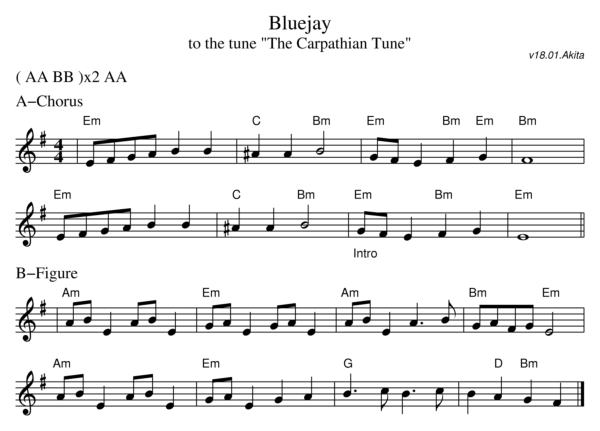Written up by Carol of Anonymous Morris, who was taught it by Boggart’s Breakfast. Other versions exist; we're not sure who Boggarts learnt it from (we’ve changed a couple of the figure names from the Boggarts version but otherwise kept it the same).
The original dance is by Mike Miller of The Bassett Street Hounds.
Instructions
This is a 4-person dance, starting in a square. The first corners are 'spinny' corners. The second corners are 'non-spinny' corners. All will become clear in the chorus. As a rough guide, there should be a clash on every beat in the chorus, and basically every odd numbered beat in the figures. In these instructions, the dancers will be referred to as follows:
| Up | ||
| 1 | 2 | |
| 3 | 4 |
| Figure | Music |
|---|---|
| Chorus | AA |
| Phi | B |
| Lightning Bolt | B |
| Chrous | AA |
| Hey Squared | B |
| Death Star | B |
| Chorus and out | AA |
Chorus (AA) |
||||||||||
|---|---|---|---|---|---|---|---|---|---|---|
| Count | Moves | |||||||||
| 1 | Clash forehand up and down (i.e. 1 with 3, and 2 with 4) | |||||||||
| 2 | Clash backhand across (i.e. 1 with 2, and 3 with 4) | |||||||||
| 3 | Dancers 2 and 3 clash forehand while moving slightly right, so that they end up aligned up and down. Meanwhile, dancers 1 and 4 spin right 450 degrees while moving backwards and left to end up with 1 behind 2 and 4 behind 3. At the end of beat 3, the dancers are in a line up and down, in order 1 2 3 4 |
|||||||||
| 4 | Dancers 2 and 3 raise their sticks above their heads (aiming for a 45 degree angle); dancer 1 clashes backhand overhead with dancer 2’s stick, and similarly dancer 4 clashes backhand overhead with dancer 3’s stick | |||||||||
| 5 | Dancers 2 and 3 clash forehand while moving slightly right, so that they end up in corners of the original square (dancer 2 is now where 1 started; 3 is now where 4 started). Meanwhile, dancers 1 and 4 spin right 360 degrees while moving forwards and left to end up in the other corners of the original square (dancer 1 is now where 2 started; 4 is now where 3 started) |
|||||||||
| 6 | Clash backhand up and down (i.e. 2 with 4, and 1 with 3) | |||||||||
| 7 | Clash forehand, still up and down | |||||||||
| 8 | All strike the ground in the middle of the square | |||||||||
| This is ¼ of the way through the chorus, and each dancer has gone ¼ of the way around the set. Beats 9-16 are similar to the above, but starting with a clash on the sides (i.e. with “across” and “up and down” swapped).
|
||||||||||
| 9 | Clash forehand across (i.e. 1 with 2, and 3 with 4) | |||||||||
| 10 | Clash backhand up and down (i.e. 2 with 4, and 1 with 3) | |||||||||
| 11 | Dancers 2 and 3 clash forehand while moving slightly right, so that they end up aligned across.
Meanwhile, dancers 1 and 4 spin right 450 degrees while moving backwards and left to end up with 1 behind 3 and 4 behind 2. At the end of beat 12, the dancers are in a line across, in order 4 2 3 1 |
|||||||||
| 12 | Dancers 2 and 3 raise their sticks above their heads (aiming for a 45 degree angle); dancer 1 clashes backhand overhead with dancer 3’s stick, and similarly dancer 4 clashes backhand overhead with dancer 2’s stick | |||||||||
| 13 | Dancers 2 and 3 clash forehand while moving slightly right, so that they end up in corners of the original set.
Meanwhile, dancers 1 and 4 spin right 360 degrees while moving forwards and left to end up in the other corners of the original square |
|||||||||
| 14 | Clash backhand across (i.e. 4 with 3, and 2 with 1) | |||||||||
| 15 | Clash forehand, still across | |||||||||
| 16 | All strike the ground in the middle of the square | |||||||||
| This is halfway through the chorus. Each dancer has gone halfway around the set.
The current formation is:
|
||||||||||
| 17-32 | Repeat moves as for 1-16. This puts everyone back where they started. | |||||||||
Phi (B) |
||||||||||||||||
|---|---|---|---|---|---|---|---|---|---|---|---|---|---|---|---|---|
| Count | Moves | |||||||||||||||
| 1-2 |
Dancers end the chorus facing approximately across. All dancers move slightly forward and right while turning 270 degrees right (a petronella, if that helps) into a long, thin diamond formation:
|
|||||||||||||||
| 3-4 | In pairs (2 with 4; 3 with 1) clash forehand on beat 3 and swap places, with 1 and 4 turning in at the end. 2 and 3 should end up in the middle slightly past each other (i.e. not side by side – 2 will be slightly closer to 1 and 3 will be slightly closer to 4 | |||||||||||||||
| 5-6 | On beat 5, in pairs (1 with 2; 3 with 4) clash backhand and 2 and 3 immediately chase round each other in a tiny circle right to end up where they started. Note it is the outside people’s responsibility to make sure the clash on beat 5 happens – the middle people can’t afford to take time to stretch out if the set is too long. |
|||||||||||||||
| 7-8 | As for beats 3-4, but from new places i.e. this time it will be 1 and 4 ending up in the middle. | |||||||||||||||
| 9-10 | As for beats 5-6, but from new places i.e. this time it will be 1 and 4 chasing round each other | |||||||||||||||
| 11-12 | As for beats 3-4 (2 and 3 will end up in the middle again) | |||||||||||||||
| 13-14 | As for beats 5-6 (2 and 3 will be chasing round each other) | |||||||||||||||
| 15-16 |
Clash forehand in pairs (1 with 2; 3 with 4) and end up in the diamond formation again
2 and 4 should be facing each other, as should 1 and 3 |
|||||||||||||||
Lightning Bolt (B) |
||||||||||||||||||||||||||
|---|---|---|---|---|---|---|---|---|---|---|---|---|---|---|---|---|---|---|---|---|---|---|---|---|---|---|
|
In this figure there is a 'lightning bolt' track on the floor. The dancers' feet go along this track for most of this figure. Use this diagram as a reference:
|
||||||||||||||||||||||||||
| Count | Moves | |||||||||||||||||||||||||
| 1-2 | Note: because the first 2 beats need to flow smoothly from the previous figure, the dancers are clashing with the 'wrong' people.
1 and 2 clash forehand and pass each other, as do 3 and 4. However, dancers 2 and 3 need to be on the lightning bolt track (i.e. they clash with someone on their right but they go forward and slightly left). Dancers 1 and 4 get past and then turn in on beat 2. |
|||||||||||||||||||||||||
| 3-4 | Dancers 2 and 3 clash backhand across the middle of the lightning bolt; turning 360 degrees right as they do so. Dancers 1 and 4 step on the spot. |
|||||||||||||||||||||||||
| 5-6 | Dancers 1 and 3 clash forehand while passing, dancer 3 turning in on beat 6. Dancers 2 and 4 clash forehand while passing, dancer 2 turning in on beat 6. Dancers 1 and 4 are now in the middle of the lightning bolt. |
|||||||||||||||||||||||||
| 7-8 | Dancers 1 and 4 clash backhand across the middle of the lightning bolt; turning 360 degrees right as they do so. Dancers 2 and 3 step on the spot. |
|||||||||||||||||||||||||
| 9-10 | Dancers 1 and 3 clash forehand while passing, dancer 1 turning in on beat 6. Dancers 2 and 4 clash forehand while passing, dancer 4 turning in on beat 6. Dancers 2 and 3 are now in the middle of the lightning bolt. |
|||||||||||||||||||||||||
| 11-12 | As for beats 3-4. | |||||||||||||||||||||||||
| 13-14 | As for beats 5-6. | |||||||||||||||||||||||||
| 15-16 | Everybody back to place: dancers 1 and 4 clash backhand and bounce back into their home places; dancers 2 and 3 dance forward into place. | |||||||||||||||||||||||||
Chorus (AA)
Hey Squared (B) |
|
|---|---|
| This is essentially a right and left through, with alternating forehand and backhand stick clashes and some spinning. The ‘outside’ people should always be turning as they move (i.e. start turning just before you clash and let the momentum of the clash help you complete the turn so that as you arrive in the next position you are facing the correct way already). The ‘inside’ people should just turn in (i.e. turn the short way) when they get to their next position. | |
| Count | Moves |
| 1-2 | Facing up and down, pass right shoulders into the other person’s place while clashing forehand on beat 1, and with outside people (2 and 3) turning 270 degrees left. |
| 3-4 | Facing across, pass left shoulders while clashing backhand on beat 3, with outside people (1 and 4 - different people!) turning 270 degrees right. You are now halfway round the square. |
| 5-6 | As per beats 1-2 |
| 7-8 | As per beats 3-4. You are now back to where you started. |
| 9-16 | Repeat as for 1-8 |
Death Star (B) |
||||||||||
|---|---|---|---|---|---|---|---|---|---|---|
| Count | Moves | |||||||||
| 1 | Clash forehand up and down (i.e. 1 with 3, and 2 with 4) while moving as though to pass right shoulder. This is similar to Hey Squared so flows nicely. In theory at the end of beat 1 all 4 dancers are in a straight line across. |
|||||||||
| 2 | First corners (1 and 4) meet in the middle and take left elbow hold while going 'forward' (i.e. they will actually be going round - they are rotating around their joined left arms). Second corners (2 and 3) dance in a circle around 1 and 4. Note from now on you have the pair in the middle spinning in one direction and the two people on the outside circling round in the other direction. The people going around the outside have to move quite swiftly. |
|||||||||
| 3 | Dancers 1 and 3 clash forehand, and so do 2 and 4 - at the point when they clash, all 4 dancers should be in a straight line diagonally across the set. The people on the outside have gone 1/3 of a circle round. The people on the inside have gone 2/3 round. |
|||||||||
| 4 | Everyone keeps going the way they are going (i.e. outside dancers keep chasing round outside, middle dancers keep rotating around the middle) | |||||||||
| 5 | Dancers 1 and 3 clash forehand, and so do 2 and 4 - at the point when they clash, all 4 dancers should be in a straight line diagonally across the set. The people on the outside have now gone 2/3 of a circle round. The people on the inside have gone around once and 1/3. |
|||||||||
| 6 | Everyone keeps going the way they are going (i.e. outside dancers keep chasing round outside, middle dancers keep rotating around the middle) | |||||||||
| 7 | Dancers 1 and 3 clash forehand, and so do 2 and 4 - at the point when they clash, all 4 dancers should be in a line across:
|
|||||||||
| 8 | 1 and 4 drop their left elbow hold. Each pair (3 and 1; 4 and 2) should look at each other and begin to dance around one another right shoulder to change places. On beat 8, dancers should be approximately halfway through changing places, i.e.
(or slightly further round) |
|||||||||
| 9 | 2 and 3 take left elbow hold as they meet in the middle; forehand clash in pairs (3 with 1; 4 with 2) on beat 9. Everyone should be clashing in the following line across:
|
|||||||||
| 10-15 | As per beats 2-7, with new inside / outside people. | |||||||||
| 16 | Get back to place ready for chorus (insides drop back, outsides go forward into place). | |||||||||
Chorus and out (AA) |
|
|---|---|
| As for a normal chorus, but on beat 32 instead of striking the ground, throw your sticks down onto the ground in the middle of the set, turn away and stride off. | |




